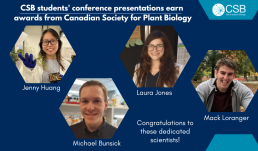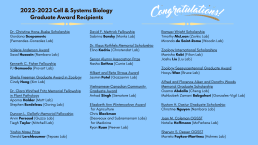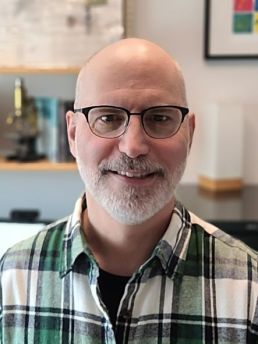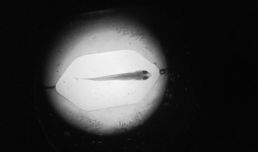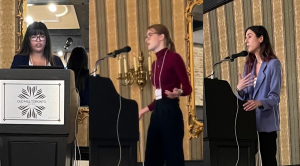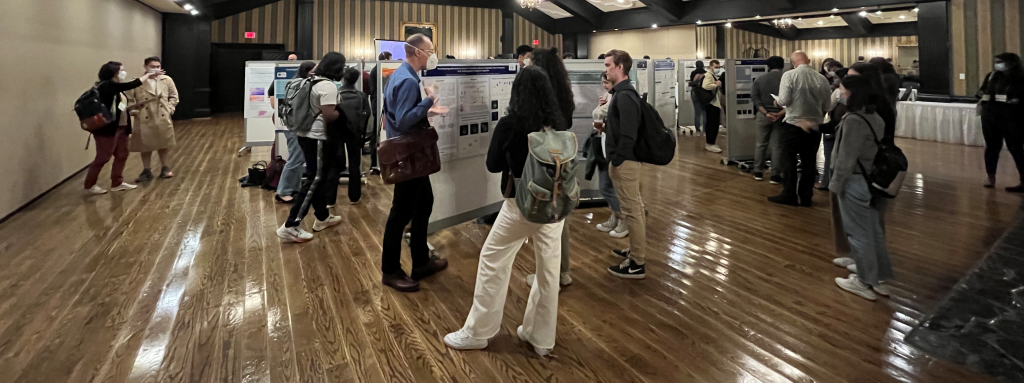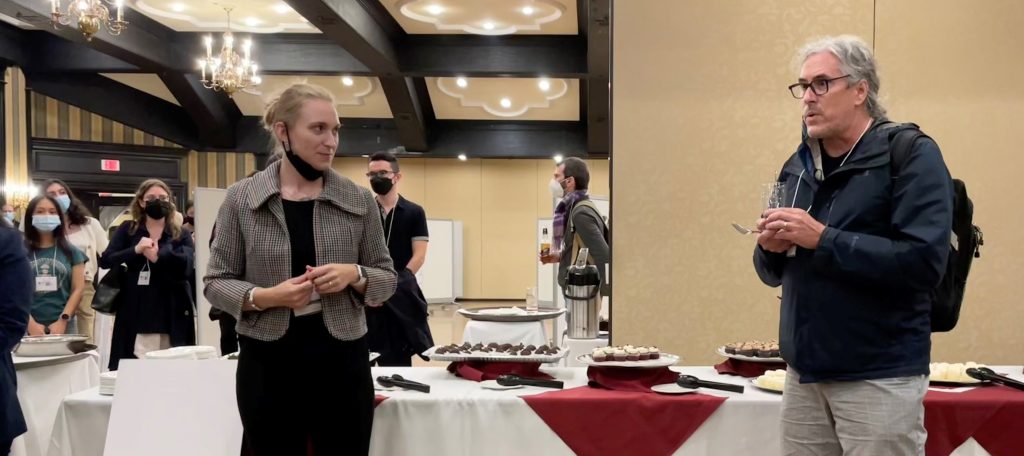CSPB awards for CSB's dedicated plant scientists
CSB students won multiple awards at the annual regional meeting of the Canadian Society for Plant Biology, held at University of Toronto Scarborough on December 3, 2022.
Jenny Huang (McFarlane lab) noted that "It was exciting to finally meet all the scientists I had only heard of by name before. The conference exposed me to a diverse range of research in the field of plant science which broadened my perspective on the kinds of projects that are available."
Huang earned her award for a talk on Sugar Code Interactors in N-glycan Quality Control. She says "I was not expecting to win an award, and I am thankful to have my work recognized". Lectins bind to N-glycosylated proteins, and Huang has identified candidate lectins in Arabidopsis with the goal of exploring their effect on glycoprotein trafficking and maturation.
Michael Bunsick (Lumba lab) was recognized for his talk on Identifying the Strigolactone Receptor in Fungi. Bunsick found that plant-derived strigolactone serves as an inter-kingdom signaling molecule which inhibits PHO84-dependent phosphate uptake in fungi.
Mack Loranger (Yoshioka lab) presented an award-winning poster describing how Diverse interactions between Solanum lycopersicum (tomato) and beneficial Canadian soil-borne bacteria regulate increased immunity.
Laura Jones (Braeutigam lab) says she was "thrilled to receive a poster award for my research on Responses of Balsam Poplar to Extreme Weather Events Simulating Late 21st Century Climate. It felt like a confirmation that people recognize the importance of studying tree physiology, particularly in the context of climate change, and find trees just as fascinating as I do!"
Congratulations to these dedicated scientists!
Congratulations to CSB's Graduate Student Award Recipients!
Congratulations to our Graduate Students who earned recognition for their accomplishments at our Graduate Student Awards on December 19th, 2022!
Valerie Anderson Graduate Fellowship
- Awarded for academic merit to an outstanding student in any subdiscipline of plant biology.
Recipient: Saad Hussain (Nambara Lab)
Kenneth C. Fisher Fellowship
- Awarded in recognition of a student who maintains a high standard of academic and research achievement, balanced with outstanding extra-curricular contributions to their department.
Recipient: PJ Gamueda (Provart Lab)
Sheila Freeman Graduate Award in Zoology
- Awarded to an incoming or in-progress graduate student focusing their studies in animal biology.
Recipient: Cindy Hong (Kim Lab)
Dr. Clara Winifred Fritz Memorial Fellowship in Plant Pathology
- Awarded to students studying in the area of plant pathology demonstrating academic excellence.
Recipients: Aparna Haldar (Mott Lab)
Stephen Bordeleau (Goring Lab)
Duncan L. Gellatly Memorial Fellowship
- Awarded each year to one or two graduate students demonstrating excellence in Virology and/or Molecular Biology research
Recipients: Arvin Persaud (Guzzo Lab)
Tiegh Taylor (Mitchell Lab)
Yoshio Masui Prize in Developmental, Molecular or Cellular Biology
- Awarded to a master’s or doctoral student in the Department on the basis of academic merit.
Recipient: Gerald Lerchbaumer (Tepass Lab)
David F. Mettrick Fellowship
- Awarded to a graduate student in CSB engaged in any aspect of zoological research.
Recipient: Sabrina Barsky (Monks Lab)
Dr. Klaus Rothfels Memorial Scholarship
- Scholarship awarded on the basis of academic standing.
Recipient: Elina Kadriu (Christendat Lab)
Senior Alumni Association Prize in Cell & Systems Biology
- Awarded to a student in the department based on academic merit.
Recipient: Nasha Sethna (Currie Lab)
Hilbert and Reta Straus Award
- Awarded to a full-time graduate student who has demonstrated high research achievement in the fields of plant molecular or cellular biology.
Recipient: Jasmin Patel (Gazzarrini Lab)
Vietnamese-Canadian Community Graduate Award in Zoology
- Awarded to a master’s or doctoral student studying animal biology based on academic merit and who exhibits research potential, excellent communication skills and leadership.
Recipient: Anhad Singh (Senatore Lab)
Elizabeth Ann Wintercorbyn Award
- This first award is made to a student engaged in research work which is likely to prove beneficial to medicine.
Recipient: Ryan Ruan (Peever Lab)
Elizabeth Ann Wintercorbyn Award
- The second half of the award goes to a student engaged in research work which is likely to prove beneficial to agriculture.
Recipient: Chris Blackman (Desveaux and Subramaniam Labs)
Ramsay Wright Scholarship in Cell and Systems Biology
- Awarded to CSB students engaged in research in zoology.
Recipients: Timothy McLean (Zovkic Lab)
Miranda de Saint-Rome (Woodin Lab)
Zoology International Scholarship
- This is the first of two awards for international students demonstrating high academic performance.
Recipient: Manisha Kabi (Filion Lab)
Zoology International Scholarship
- This is the second award, again, going to international students demonstrating high academic performance.
Recipient: Jiashu Liu (Liu Lab)
Zoology Sesquicentennial Graduate Award
- Awarded to a graduate student enrolled in full-time studies in CSB, on the basis of academic merit.
Recipient: Haoyu Wan (Bruce Lab)
Alfred and Florence Aiken and Dorothy Woods Memorial Graduate Scholarship in Cell and Systems Biology
- Awarded based on academic merit.
Recipients: Osama Abdalla (Cheng Lab)
Mahbobeh Zamani Babgohari (Gonzales-Vigil Lab)
Rustom H. Dastur Graduate Scholarship in Cell and Systems Biology
- Awarded to a graduate student studying plant sciences, on the basis of academic merit.
Recipient: Christine Nguyen (Nambara Lab)
Awards from earlier this year:
Dr. Christine Hone-Buske Scholarship for Outstanding Publication by a PhD Student
(Awarded in March)
Recipient: Gordana Scepanovic (Fernandez-Gonzalez Lab)
Joan M. Coleman Ontario Graduate Scholarship in Science and Technology
(Awarded in June 2022 as part of the OGS competition)
Recipient: Natalie Hoffmann (McFarlane Lab)
Sherwin S. Desser Ontario Graduate Scholarship in Science and Technology
(Awarded in June 2022 as part of the OGS competition)
Recipient: Mariela Faykoo-Martinez (Holmes Lab)
Congratulations to Highly Cited Researcher Prof David Guttman!
Department of Cell & Systems Biology (CSB) Professor David Guttman has been recognized as a Highly Cited Researcher in 2022 by the science analytics firm Clarivate. This award is evidence that Guttman's peers frequently refer to his work as they build toward improvements in plant and animal health. Dr. Guttman is highly cited across many fields of study through his work on understanding how bacteria adapt to and manipulate their hosts, the evolution of bacterial host specificity and virulence, and decoding the important role played by microbial communities (i.e., microbiomes) in maintaining the health of their hosts.
Dr. Guttman's lab works in close collaboration with CSB Professor Darrell Desveaux. This collaboration unites expertise in evolutionary, comparative, and mechanistic biology to bring new perspectives to the study of host-pathogen interactions. The Guttman – Desveaux collaboration focuses on 'effector' proteins secreted by bacteria that can manipulate host cells and suppress immunity.
Importantly, these effectors can also be co-opted by hosts as signals of infection in a process known as effector-triggered immunity. Guttman must therefore consider the dual role of secreted pathogen effectors as both virulence factors and immune elicitors.
An important component of Dr. Guttman’s research is to assess the global genomic diversity of pathogens and their plant hosts by sequencing bacterial strains and plant varieties collected from across the globe. This 'pan-genome' analysis gives him a comprehensive view of the diversity of genetic factors involved in host-pathogen interactions and how these factors change through evolutionary time.
A highly cited paper from 2020, published in the journal Science, used comparative and functional approaches to classify effectors and assess their potential for eliciting effector-triggered immunity. While this study, "The pan-genome effector-triggered immunity landscape of a host-pathogen interaction" focused on a single ecotype of the model plant Arabidopsis thaliana, it still uncovered a surprising level of potential immune responses and two novel plant immune receptors.
More recent studies within brassicaceous crops related to Arabidopsis, within soybean, and within tomato are assessing how effectors suppress immunity in these crop plants and how this immunity has changed over the course of crop domestication.
Several exciting findings have already come out of this work, such as when Guttman and Desveaux turned their attention to tomatoes and their wild relatives, where they were "surprised and frustrated" by the lack of diversity in effector-mediated immune responses. They are currently pursuing this puzzling reduction in immune diversity with collaborators in Spain and Ontario.
A new paper in 2022 is a breakthrough in statistical analysis for probing the evolution of host-specificity and virulence in pathogenic bacteria. Dr. Ceda Bundalovic-Torma, a postdoc in the Guttman lab, developed a novel measure of evolutionary diversity that takes into account horizontal gene transfer.
Bacteria growing together in a microbiome can pass genetic material between evolutionarily divergent cells within a population through horizontal gene transfer. Existing diversity measures fail to consider this transfer, so Guttman's researchers developed RecPD, an "interesting and fun" conceptual approach to computationally quantify genetic diversity.
Dr. Guttman's expertise in genomic data science and microbiome analysis has enabled him to collaborate on a wide range of exciting, high-profile, and highly-cited human microbiome studies. His role as Director of the Centre for the Analysis of Genome Evolution & Function (CAGEF), a core facility that assists other research groups with their genomics and proteomics studies has also facilitated these collaborations. This work has led to important new insights into the role played by microbial communities in human health and disease.
Dr. Guttman's experience makes him a valuable member of advisory boards for the Emerging & Pandemic Infections Consortium (EPIC), the Canadian Statistical Sciences Institute (CANSSI) Ontario, and the Data Sciences Institute (DSI). His work is leading to a better understanding of where the genetic potential for virulence originates, how this potential is maintained in bacterial populations, and how pathogen evolution impacts the fitness of their plant and animal hosts.
Congratulations, Dr Guttman!
Canadian Foundation for Innovation profiles Prof Guttman's research
The Canadian Foundation for Innovation (CFI) funds research in Professor David Guttman's lab on understanding how bacteria adapt to and manipulate their hosts. CFI has shared a profile of Guttman's work as "Blueprints for boosting plant immunity: How sophisticated genomics could help address food insecurity by giving crops an edge in the arms race against pathogens." This story by Julie Stauffer concludes that the insights he gains into the constantly evolving struggle between plants and their invaders could ultimately lead to more resistant crops — and more food on dinner plates around the world.
You read this profile on Prof Guttman's research at https://www.innovation.ca/projects-results/research-stories/blueprints-boosting-plant-immunity.
CSB recruits Professor Qian Lin for systems neuroscience in a new city
We are pleased to welcome Qian Lin, who has joined us as Assistant Professor in CSB to work on systems neuroscience, at the intersection of computational biology and neurobiology. In her experiments, she observes neurons light up across the entire brain as zebrafish make decisions in order to understand how the brain generates complex behaviours. She observes that “The whole brain is involved in decision making, but where is the best place to start? I start by using the cerebellum as the entry point.”
Her work challenges assumptions of how decision-making and movement are related in the brain. The cerebellum was long viewed as being solely involved in motor control, but Prof Lin's work and others have shown that there is no strict dualism of cognition and behaviour. Preparatory activity in the cerebellum is predictive of a decision to turn left or right, and of signals to take action.
Professor Lin reflects on this phenomenon as she learns a new punch or kick when practicing martial arts. She senses that the decision and the movement become closely linked and reflects on how this process occurs in her own brain.
An international scholar comfortable in China, Austria or the States, Lin grew up in the countryside of Hubei province. She would devour all the books in her home, at her neighbours’ homes and in the small school library. When she looked up from the pages of her Nature books, Lin would observe the animals all around her and wonder “What are they thinking about?”
As the first one in her extended family to start university, Lin had no single interest and thought she might follow her family into teaching. However, a field trip to Yunnan province revealed the great variety in biology as she gazed at the giant water lilies in Xishuangbanna Tropical Botanical Garden. She then applied herself to studies in structural biology, computational biology and neuroscience.
Lin left China in 2011 to start her PhD at the National University of Singapore supported by a NGS scholarship. The transition was difficult due to the culture and the language barrier of a new country. Her scholarship was dependent on maintaining good marks, which added to the stress of the transition. She was grateful that her supervisor Suresh Jesuthasan and labmates didn’t let her sit in the corner by herself doing experiments but invited her to join them and supported her studies.
Lin’s PhD lab used zebrafish as a model system to study sensory representation and behaviour. The transparent bodies of live zebrafish larvae allowed them to view the entire nervous system. Lin found herself imagining complex behaviour experiments while she studied the neurobiology of light processing.
“I find neural circuits fascinating as you can get close to understanding underlying neural mechanisms”, says Lin. “By acquiring quantitative results, you approach the idea of predicting what zebrafish will do. Since you can see each cell within the transparent body, you can target specific regions of the brain to change their behaviour.”
Lin chose Alipasha Vaziri’s lab in Vienna for her post-doctoral research using new optical neurotechnologies to study complex behaviours. Early days in the lab were a struggle, with no results from her zebrafish training during the first six months. There was added difficulty as the lab moved to New York. Over time and with perseverance, her results poured in and careful analysis resulted in a publication in the prestigious journal Cell: “Cerebellar Neurodynamics Predict Decision Timing and Outcome on the Single-Trial Level”.
Lin acknowledges that being a scientist can be emotionally draining due to the various challenges it entails. For her, the stress of working as a post-doc with a toddler while seeking a faculty position during the pandemic stands out. Lin emphasizes that it’s important that you don’t give up. She finds it best to relieve tension through physical activity like martial arts and finding challenges that keep you mentally sharp. Lin advises that as things become more difficult, you develop the competency to deal with them and at some point you won’t have to relive how hard it used to be.
 “My best decision was choosing an academic career,” Lin reveals. “With a PhD in neuroscience, I could have chosen to join industry as a data scientist or to continue in academia as a post-doc or professor. I chose academia because doing research is what I enjoy most.”
“My best decision was choosing an academic career,” Lin reveals. “With a PhD in neuroscience, I could have chosen to join industry as a data scientist or to continue in academia as a post-doc or professor. I chose academia because doing research is what I enjoy most.”
If you were to join Prof Lin’s lab as a student or post-doc, research would require some tool building of, for example, behavioural rigs, and would then occur on a weekly cycle: she prepares fish, images their brains and behaviour over 3 whole days, with two days for data analysis using code written in MatLab or Python. This all leads to a visualization of the process over time.
We are grateful that Prof Lin has chosen the Department of Cell & Systems Biology for her academic career. “I find Toronto to be chilly, but it is pleasantly quiet compared to New York. The neighbourhoods are very family friendly, with lots of nature and wildlife in the parks.” notes Lin. “My colleagues here have been generous with their protocols and with sharing their grant applications to help me to get my own funding.” We look forward to having her in the Department. Welcome!
Discoveries and Discussions at CSB Research Day
CSB held our Research Day for the first time in 2 years on September 22nd, 2022. Over 180 students, staff and faculty gathered at the Old Mill to hear the latest advances in research in the department. In his opening remarks, Graduate Associate Chair John Peever remarked how glad he was to see everyone in 3D after years of Zoom screens.
Our Keynote Speaker Prof Teresa Lee wowed the crowd with her detailed work on the epigenetics of longevity in C elegans. It was a pleasure to host her.
We are grateful to our alumni speakers who shared their career paths with our students. Declan Ali related fond stories of the Lange lab that led to his position as Chair of Biological Sciences at the University of Alberta. Gazzarrini lab graduate Carina Carianopol shared her more recent path to industry at Platform Genetics and related the joys of living in Niagara.
Trainee presentations were judged in different formats by faculty, post-docs or by applause. In addition to cash awards, some outstanding presenters also received prizes donated by Millipore-Sigma.
Oral Presentations
Senior students presented the details of their research in oral presentations with faculty scoring their presentations.
Jasmin Patel of the Gazzarrini lab at UTSC scored the highest marks for her talk on “Transcriptional regulation of FUSCA3 during seed coat development in Arabidopsis thaliana”
Our next award winner was Clare Breit-McNally of the Desveaux and Guttman labs at UTSG, who spoke on “The effector-triggered immunity landscapes of two Brassicaceous oilseed crops”
The final award went to “Spalt and Disco Define the Dorsal-Ventral Axis of the Developing Drosophila Medulla” from Priscilla Valentino of the Erclik lab at UTM. For more details on this research, you can read her brand new publication in the journal Genetics.
Lightning Talks
Our Lightning Talks event gave students three minutes to introduce their topic and to relate their findings. These rapid-fire talks were judged by the enthusiasm of the audience response.
Vineeth Andisseryparambil Raveendran from the Woodin lab was awarded the prize for his Lightning Talk on “Enhancing potassium-chloride co-transporter-2 (KCC2) function in neurons by targeting protein-protein interactions”. As the presenter who received the loudest applause, he was presented with some additional Millipore-branded gifts.
Ernest Iu, Milena Russo, Gregor McEdwards and Kailynn MacGillivray also won awards for the enthusiastic waves of applause inspired by their talks.
Poster Session
While attendees sampled canapes and drinks from the bar, mid-PhD students gave poster presentations over two sessions that were judged by faculty and post-doctoral researchers.
Samiha Benrabaa received the highest scores of all the poster winners, earning a special selection of Millipore-donated goods for her poster on “Ecdysteroid-signaling and reproduction in Rhodnius prolixus, a vector of Chagas disease”.
Russell Luke, Samuel Delage and Tamar Av-Shalom also earned awards for their excellent poster presentations.
As the day wrapped up, CSB chair Nick Provart gave his warm thanks to the organizing committee and its leader, Madison Marshall for a flawless day.
Compassion and Commitment earn Jade Zhang the 2022 Nyman Scholarship
 Congratulations to New College student Jade Zhang, who has been awarded the Dr Leslie Paul Nyman scholarship. This award recognizes a plant biology student who has made a stellar impact through community service activities.
Congratulations to New College student Jade Zhang, who has been awarded the Dr Leslie Paul Nyman scholarship. This award recognizes a plant biology student who has made a stellar impact through community service activities.
Zhang excelled in our Molecular Plant Biology lab course CSB350, where she was excited to acquire new techniques from Professors Nambara and Christendat. She was especially glad to get her hands on scientific equipment, rather than seeing the equipment through a screen in virtual labs.
Zhang is committed to helping others. In her first year at New College, Zhang felt college events weren’t helping her connect with her peers. To ensure that her fellow students would feel connected, she joined residence council and student council. In her early years as junior house representative, Zhang was grateful to upper year students who provided her guidance.
Zhang applied her leadership skills to planning orientation events, enhancing their impact through reflecting on her first-year experiences. Her success was demonstrated by successive re-elections as student representative. For New College students at home over the pandemic, contacting her was a moment of escape to talk to someone new.
Her technical skills on virtual platforms provide support for New College and UofT to organize mental health programs. Both the UofThrive and SMART programs benefited from applying her experience in helping students connect and develop during the pandemic.
"If you can help someone, why not do it?" is the straightforward creed Zhang learned from her family and applies in her life.
Congratulations, Jade Zhang!
Fresh perspectives from a CSB summer course overseas
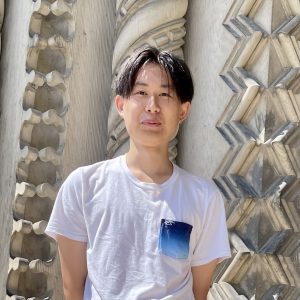
Yutei Shi (UC’23) is returning from an overseas summer course with a new perspective on what’s important to him in his studies and in his career in biology. The CSB397 Research Abroad course offers UofT students a chance for experiential learning through lab-based research in select cities around the world. Shi had hoped to travel to Hong Kong, but COVID restrictions made Konstanz, Germany the best alternative for a host lab.
Shi was accepted to Prof Patrick Müller’s lab, which uses light sheet microscopy to study the development of zebrafish embryos. Shi was nervous to be travelling to a new country and imagined his days would be filled with experiments and paperwork.
He was pleasantly surprised by his reception: “The lab was really helpful and sociable. We would go out for drinks some days on the lawn. Working there really showed me the importance of work-life balance”.
Shi had lab experience from attending teaching labs at U of T, but Müller was interested in his hobby of creating virtual objects using 3D sculpting software. Shi applied his knowledge of coding 3D objects to develop machine learning models for determining the position and orientation of a 2D slice of a fish embryo within the 3D space of the fish embryo. Before moving to the keyboard, Shi was taught at the lab bench to prepare samples through embryo injection, PCR screening and fluorescent imaging.
Shi also took the opportunity of being in Europe to travel with fellow CSB397 students to cities including Madrid, Naples, and Rome. He was struck by how the urban geography of all the cities he visited was derived from the ancient patterns he saw in Rome. Even his train journeys west through Switzerland afforded beautiful views of the Alps. Shi developed an interest in European history from his travels and discussions with his landlord.
With support from Centre for International Experience, Shi had funds to pay rent for a room he found online and for living expenses in Konstanz. This support has revealed to Shi that he wants to find a job in industry upon graduation to provide the stability of a regular salary and the freedom to have his own room.
For students curious about applying to CSB397, the University has previously arranged positions in Hong Kong, Singapore, Japan, Belgium, Czech Republic, Denmark, Germany and Scotland. More information can be found on the CSB397 webpage. A final list of CSB destinations for Summer 2023 will be available in Fall 2022.
Professor Chang's Research Featured in The Atlantic
Dr Sarah Dungan was interviewed about her work in Professor Chang's lab on reconstructing ancestral rhodopsin in cetaceans. The story was published in the Atlantic as "What Did Ancient Whales See?" (external link).
CSB Graduate Wins Award for Best Plant Biology Paper of 2021
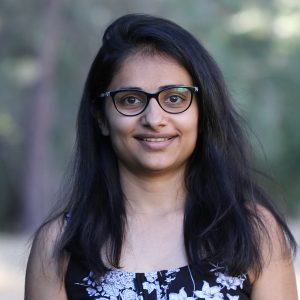 The 2021 Ragai Ibrahim Award for best student paper in plant biology was awarded to CSB graduate Dr Purva Karia by the Canadian Society for Plant Biology (CSPB). . Karia’s award-winning research in Prof Keiko Yoshioka’s lab identified key molecular changes responsible for regulating senescence-related programmed cell death in plants. Dr Karia says ”I’m honored to receive this recognition by CSPB! Thanks to Keiko Yoshioka for the nomination.”
The 2021 Ragai Ibrahim Award for best student paper in plant biology was awarded to CSB graduate Dr Purva Karia by the Canadian Society for Plant Biology (CSPB). . Karia’s award-winning research in Prof Keiko Yoshioka’s lab identified key molecular changes responsible for regulating senescence-related programmed cell death in plants. Dr Karia says ”I’m honored to receive this recognition by CSPB! Thanks to Keiko Yoshioka for the nomination.”
Programmed cell death is initiated in individual cells within a leaf by the active and highly regulated process of leaf senescence. Initiation of leaf senescence occurs naturally by aging, as when leaves turn yellow during autumn.
Senescence can also be induced by a range of external factors such as drought or darkness. This response is mediated by hormones including abscisic acid (ABA). Karia’s studies have revealed a molecular switch to prevent untimely aging which has potential for improving crop yields.
Karia showed that the TTM1 protein, which is localized in the mitochondrial outer membrane, plays an important role in senescence-associated cell death. Her experiments demonstrate that plants lacking TTM1 have delayed natural and ABA-induced senescence, indicating that TTM1 has a universal role as a positive regulator of senescence-related programmed cell death.
A number of TTM1 phosphorylation sites were published in phosphoprotemics studies, but Karia’s work revealed the biological significance of TTM1 phosphorylation. Testing senescence cues including ABA and darkness demonstrated that TTM1 undergoes phosphorylation events at three major sites. Upon perception of senescence cues, multiple MAP kinases phophorylate TTM1, which in turn regulates TTM1 function and turnover.
Karia made specific changes to TTM1 that mimic or block phosphorylation and observed changes in senescence. Karia says “I’m amazed that plants are smart enough to determine in such a fine-tuned manner when it is time to age. It’s impressive that even a minor tweak in phosphorylation can cause changes in aging.”
This result reveals a novel link between ABA, mitochondria, and programmed cell death in plants via TTM1. This opens up a new direction to establish the role of mitochondria in the execution of programmed cell death during the process of senescence and provide a target mechanism for improving drought resistance.
Professor Ragai Ibrahim established his named CSPB award to recognize excellence in research publication by plant biology students. Karia’s award-winning paper in The Plant Journal is titled “Multiple phosphorylation events of the mitochondrial membrane protein TTM1 regulate cell death during senescence”. Congratulations!
Karia is now leading the Sorghum Metabolic Atlas project at Carnegie Science in Stanford, California for her post-doctoral research. Sorghum is a drought resistant crop and by linking the location of metabolic enzymes to their function, Karia and lab head Prof Sue Rhee hope to be able to transfer drought resistant capabilities to other crop plants.

